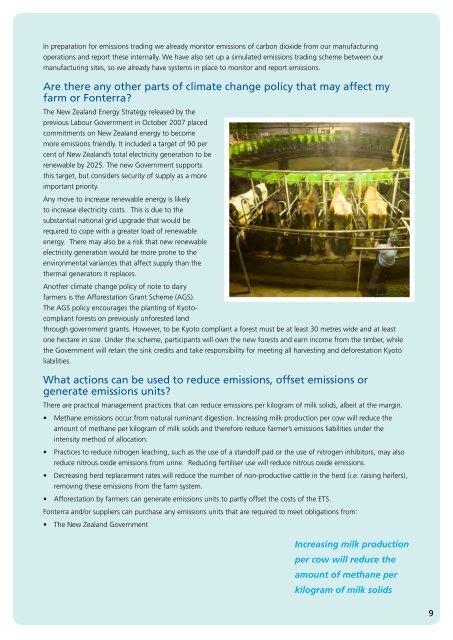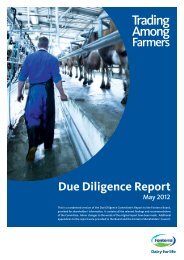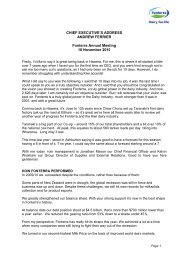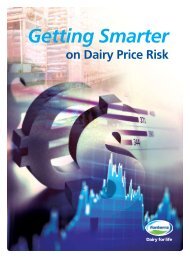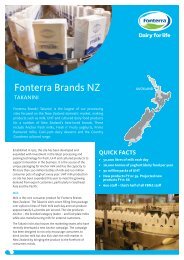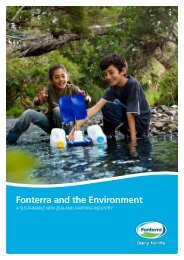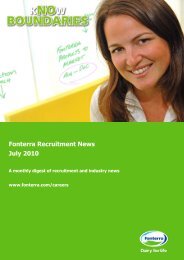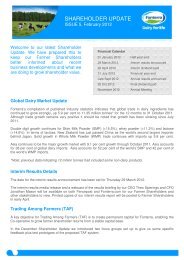A Fonterra Guide to Climate Change
A Fonterra Guide to Climate Change
A Fonterra Guide to Climate Change
- No tags were found...
Create successful ePaper yourself
Turn your PDF publications into a flip-book with our unique Google optimized e-Paper software.
In preparation for emissions trading we already moni<strong>to</strong>r emissions of carbon dioxide from our manufacturingoperations and report these internally. We have also set up a simulated emissions trading scheme between ourmanufacturing sites, so we already have systems in place <strong>to</strong> moni<strong>to</strong>r and report emissions.Are there any other parts of climate change policy that may affect myfarm or <strong>Fonterra</strong>?The New Zealand Energy Strategy released by theprevious Labour Government in Oc<strong>to</strong>ber 2007 placedcommitments on New Zealand energy <strong>to</strong> becomemore emissions friendly. It included a target of 90 percent of New Zealand’s <strong>to</strong>tal electricity generation <strong>to</strong> berenewable by 2025. The new Government supportsthis target, but considers security of supply as a moreimportant priority.Any move <strong>to</strong> increase renewable energy is likely<strong>to</strong> increase electricity costs. This is due <strong>to</strong> thesubstantial national grid upgrade that would berequired <strong>to</strong> cope with a greater load of renewableenergy. There may also be a risk that new renewableelectricity generation would be more prone <strong>to</strong> theenvironmental variances that affect supply than thethermal genera<strong>to</strong>rs it replaces.Another climate change policy of note <strong>to</strong> dairyfarmers is the Afforestation Grant Scheme (AGS).The AGS policy encourages the planting of Kyo<strong>to</strong>compliantforests on previously unforested landthrough government grants. However, <strong>to</strong> be Kyo<strong>to</strong> compliant a forest must be at least 30 metres wide and at leas<strong>to</strong>ne hectare in size. Under the scheme, participants will own the new forests and earn income from the timber, whilethe Government will retain the sink credits and take responsibility for meeting all harvesting and deforestation Kyo<strong>to</strong>liabilities.What actions can be used <strong>to</strong> reduce emissions, offset emissions orgenerate emissions units?There are practical management practices that can reduce emissions per kilogram of milk solids, albeit at the margin.• Methane emissions occur from natural ruminant digestion. Increasing milk production per cow will reduce theamount of methane per kilogram of milk solids and therefore reduce farmer’s emissions liabilities under theintensity method of allocation.• Practices <strong>to</strong> reduce nitrogen leaching, such as the use of a standoff pad or the use of nitrogen inhibi<strong>to</strong>rs, may alsoreduce nitrous oxide emissions from urine. Reducing fertiliser use will reduce nitrous oxide emissions.• Decreasing herd replacement rates will reduce the number of non-productive cattle in the herd (i.e. raising heifers),removing these emissions from the farm system.• Afforestation by farmers can generate emissions units <strong>to</strong> partly offset the costs of the ETS.<strong>Fonterra</strong> and/or suppliers can purchase any emissions units that are required <strong>to</strong> meet obligations from:• The New Zealand GovernmentIncreasing milk productionper cow will reduce theamount of methane perkilogram of milk solids9


